A
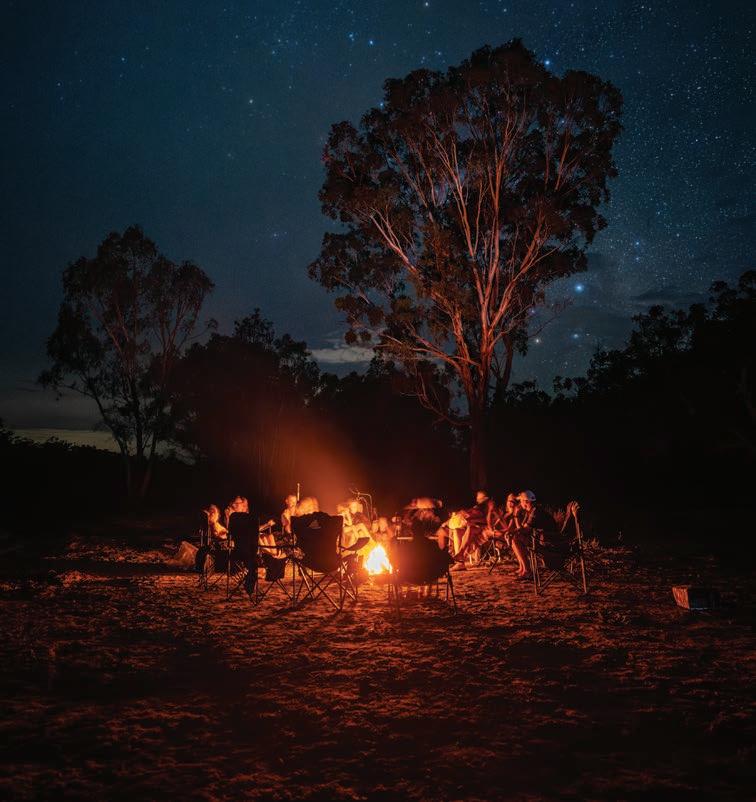


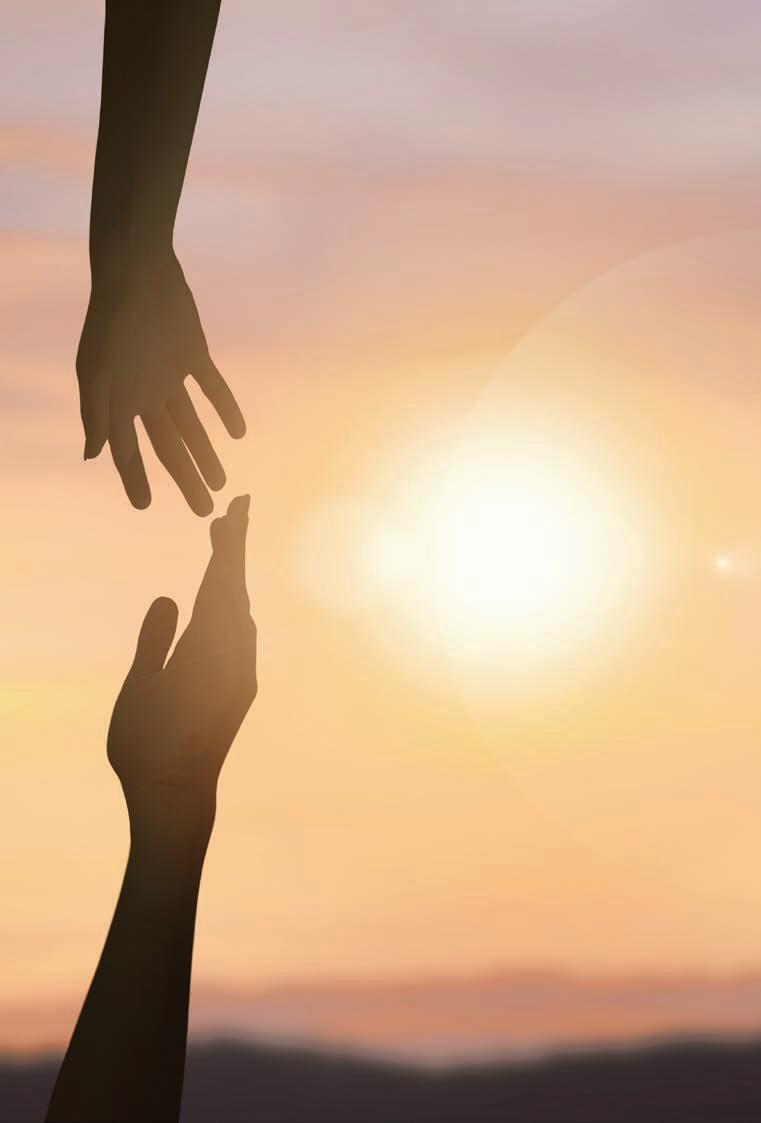
“To love means loving the unlovable. To forgive means pardoning the unpardonable. Faith means believing the unbelievable. Hope means hoping when everything seems hopeless.”
– G K Chesterton
The Salvation Army, an international movement, is an evangelical part of the universal Christian Church.
Vision Statement
Wherever there is hardship or injustice, Salvos will live, love and fight alongside others to transform Australia one life at a time with the love of Jesus.
Mission Statement
The Salvation Army is a Christian movement dedicated to sharing the love of Jesus by:
• Caring for people
• Creating faith pathways
• Building healthy communities
• Working for justice
The Salvation Army Australia acknowledges the Traditional Owners of the land on which we meet and work and pay our respect to Elders, past, present, and future. We value and include people of all cultures, languages, abilities, sexual orientations, gender identities, gender expressions, and intersex status. We are committed to providing programs that are fully inclusive. We are committed to the safety and wellbeing of people of all ages, particularly children.

Spirituality is alive and well in Australia – although what that means and how it looks is different for each of us.
In this edition of Salvos Magazine, our writers explore the increasingly discussed topic of spirituality and the underlying search for hope, connection and peace.
Lieut-Colonel Lyn Edge shares some insights from the recently published McCrindle Research report, An Undercurrent of Faith, which shows that Australia is not an entirely secular society, but reflects a deep, quiet and enduring interest in the spiritual.
Anthony Castle writes about how the term ‘spirituality’ is used and how for him, it’s about connection – what connects people to goodness, life, and the “divine love” at the centre of it all.
Scan here to connect with The Salvation Army services
Scan here to subscribe to Salvos Magazine
Founders: William and Catherine Booth
Salvation Army World Leaders: General Lyndon and Commissioner Bronwyn
Buckingham
Territorial Leader: Commissioner Miriam Gluyas
Secretary for Communications and Editor-In-Chief: Colonel Rodney Walters
Publications Manager: Cheryl Tinker
Editor: Simone Worthing
Graphic Designer: Ryan Harrison
Enquiry email: publications@salvationarmy.org.au
All other Salvation Army enquiries 13 72 58
Press date: 29 August 2025
Printed and published for The Salvation Army by Commissioner Miriam Gluyas at Focus Print Group, Chester Hill, NSW, Darug Nation lands.
Amanda Brummell-Lennestaal shares how she knows that God is real, and how she sees and feels him in the “authentic, the raw, the vulnerable – the sacred ordinary”.
Stan Grant describes how his return to Wiradjuri land, connecting with his roots and being on Country enabled him to feel God’s presence again.
For these stories and more, go to salvosonline.org.au
Simone Worthing Editor
by Lyn Edge
Search ‘spirituality’ online and you’ll be met with a flood of images of light beams, lotus flowers, and people meditating in yoga poses. While those images speak to one form of spiritual expression, they don’t quite match the everyday Australians I know. You won’t find many of us in lotus position on the beach at sunrise. But does that mean Aussies aren’t spiritual? Or is there a uniquely Australian spirituality that isn’t seen on an internet image search?
Back in 2007, Australian sociologist Gary Bouma explored this very question in his book Australian Soul. He challenged the idea that spiritual life in Australia was fading, arguing instead that it had simply taken on a quieter, more personal form. “Australians”, he wrote, “tend to express their spirituality in more understated ways than in other Western countries.” He called it a kind of “laidback” spirituality, less tied to formal religion, but still real and meaningful.
Bouma reflected the words of historian Manning Clark, who famously described the Australian spiritual sensibility as “a shy hope in the heart”. Clark wrote, “There is a profound shyness –yet a deeply grounded hope – held tenderly in the heart of Australia. It is not characteristically Australian to trumpet encounters with the spiritual … Australians hold the spiritual gently in their hearts, speaking tentatively about it.”
That image of a quiet, fragile hope is still relevant today, according to recent research.
Just a couple of months ago in June 2025, McCrindle Research published a major report titled An Undercurrent of Faith. Drawing on census data and a national survey of over 3000 Australians, the findings push back on the idea that Australia is becoming entirely secular. Instead, they reveal something deeper flowing
beneath the surface: a quiet, enduring interest in spiritual things.
In fact, nearly half of all Australians say they prayed in the past week. Unsurprisingly, most people who identify as religious reported praying regularly, but so did 12 per cent of those who say they have no religion at all. Even among people who don’t identify with any faith, some still find themselves reaching out to something, or someone, beyond themselves. And there’s more. The same report found that 19 per cent of Australians say they’re significantly open to changing their religious views. That number has been rising steadily – from just 8 per cent in 2011, to 12 per cent in 2017, and now nearly one in five. Even among the non-religious, 12 per cent are open to rethinking their stance.
So, what’s drawing people in? It’s not hype or celebrities. Seventy per cent of Aussies say they find celebrity endorsements
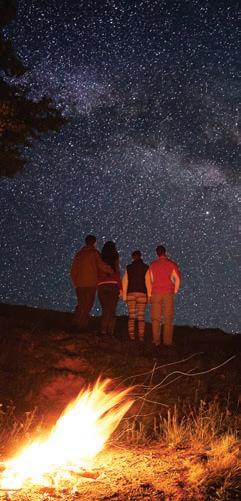
of Christianity off-putting. We tend to be wary of showiness, and we’re more interested in genuine relationships than public displays of faith.
What draws Australians to Christianity is the sense of community and belonging (36 per cent), the peace and hope it offers (33 per cent), and the way it inspires compassion and care for others (30 per cent). These things matter, especially when life gets tough, or when you’re searching for something deeper.
Australian spirituality shows up not just in church
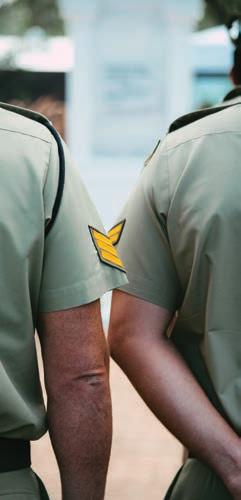
buildings, but around fire pits, in shared meals, in quiet conversations. You can see it at dawn on Anzac Day, when people gather in silence and remembrance. These moments may not be overtly religious, but they carry weight. They connect people to one another and to something bigger than themselves. In a way, they’re sacred.
So, if you were to google ‘Australian spirituality’, maybe the images that would better reflect our national soul wouldn’t be beams of light or yoga mats. Maybe they’d be mates talking deeply over

dinner, people standing side-by-side at a dawn service, someone walking barefoot along the beach, or volunteers serving in a community kitchen.
Because while the form of spirituality in Australia may be changing, the hunger hasn’t gone away. Aussies are still searching – for hope, for connection, for peace. And while we might not shout it from the rooftops, deep down, many of us still carry that “shy deeply grounded hope in the heart”.
Lieutenant-Colonel Lyn Edge is a Salvation Army officer (pastor) in NSW
The divine love at the heart of it all
by Anthony Castle
I don’t like the term spirituality.
I should. I use the word all the time. If I am trying to explain my worldview or the work I have done in faith-based communities, I typically refer to ‘spirituality’ when describing this part of my life. It’s useful, people get the right idea, but there’s just one problem.
I don’t really know what it means.
Spiritual everything
When I hear the term spirituality used in the media or in conversation, I find it can apply to almost anything. Church is spiritual. Yoga is spiritual. A sunset is spiritual. Poetry, Feng shui, hiking, food, are all things I have heard described as spiritual.
I do understand why. These experiences are meaningful to people. Something in me is unsatisfied with the questions it raises. Is spirituality just whatever we want it to be? Is it vibes? Whatever brings
enjoyment? Is spirituality more than feelings?
The idea of ‘spirit’ varies from usage to usage. Different religions have different definitions of what spirituality means. Beliefs in God, in a soul, in spirits, in realities beyond the natural world are not guaranteed from tradition to tradition, with no shared definition of the terms.
How spiritual someone is can often reflect their religious observance or the rules they follow. Someone might be considered spiritual if they practise acts of prayer, meditation, fasting or worship. These things were once typical of almost everyone’s lives in past times, default in a number of cultures.
The idea of practising religion as a default part of your culture also feels unsatisfying. Does following religious practices alone make you spiritual? What if you pray or meditate without any faith? What if it’s habit? What if you’re forced to? What if there’s no feeling attached at all?
Spirituality can’t just be something we feel, but it can’t just be something we do either. More than vibes or rules, does spirituality mean something bigger than both? I wonder about what’s in between, about what connects these things.
The biblical tradition talks about spirituality, often a translation of the Greek word ‘pneuma’ or the Hebrew word ‘ruach’, meaning breath or wind. In Scripture, God is described as a wind, as spirit shaping the world (Genesis chapter 1, verse 2; John chapter 4, verse 24).
When things are moved by God, breathed by the spirit, those things become spiritual in themselves. For example, the Scriptures are God-breathed and spiritual (2 Timothy chapter 3, verses 16-17), as is humanity itself (Genesis chapter 2, verse 7).
The biblical idea of spirituality isn’t about religiosity and rules, not about feelings or practices

alone, but about a divine connection we find in between things. There is something spiritual about the world, something spiritual about religious faith, yes, but something spiritual about us all. “In God we live, and move, and have our being” (Acts chapter 17, verse 28).
In the Bible, Jesus is asked which of the religious rules is most important, about what might best define a spiritual life. Jesus answers by quoting his own religious faith; to love your God and to love your neighbour (Luke chapter 10, verse 27). Jesus doesn’t define a religious life or spirituality as
feelings or practices alone, but by a connective love that should define them.
I have practised spirituality in different ways across my life. I have read the Bible cover to cover and explored other traditions. I have prayed by routine, meditated each morning, and fasted for days. Some of this was helpful, some of it was not. My experiences of these things can change with time, but what I keep coming back to is that connective love, and what it looks like in my life.
The Bible says that spirituality should result in feelings and practices; in love, joy, peace, forbearance, kindness, goodness, faithfulness, gentleness and selfcontrol (Galatians chapter 5, verses 22-23). This isn’t just about what we feel or what we do, but how faith and works are connected.
I don’t really know what spirituality means to everyone, but I have found what it means to me.
I honour what connects people to goodness and life, regardless of how it looks, and am satisfied with my own definitions. I don’t need to like the term spirituality, as long as I remember the divine love at the heart of it.
Burwood Salvos in Sydney’s Inner West has achieved an outstanding result in this year’s Red Shield Appeal.
Led by Captains Rong Fu and Dillon Wu, Burwood Salvos is located in an area densely populated by international students and migrants. Since beginning in Burwood in 2018, Rong and Dillon have built strong connections with local donors, partnering with the Burwood Chamber of Commerce in 2023.
For this year’s Red Shield Appeal, staff and volunteers at Burwood Salvos managed to raise more than 2.5 times what they raised in 2024. In 2024, they raised an impressive $32,000. In 2025, they raised an outstanding $83,000.
At the time of the 2021 Census, almost 50 per cent of respondents from Burwood stated their ancestry was Chinese, compared with just 7.2 per cent of those surveyed across New South Wales.
“We do PLPs (Positive Lifestyle Programs), support the youth [and] young adults, [a] Christmas barbecue, a community meal and cafe, all these things,” Rong said.
Rong said the church planned to use the funds to hire a Youth and Young Adult Community Engagement Worker to connect with the international students, youth and young adults in the local community, and extend the hours for the Hope Café program, which supports local women through a Women’s Engagement Worker available onsite. She said the rest

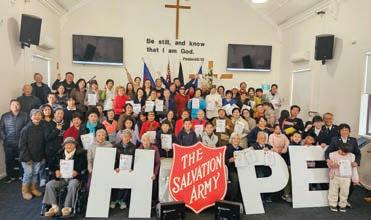
Captains Dillon Wu and Rong Fu (centre) and members of the Burwood Salvos. Image: Supplied
Burwood Salvos members with their certificates after an ‘Appreciation Day’ service. Image: Supplied
of the funds would go to other existing programs, such as English classes, a women’s hope group, a Chinese children’s Bible class, parenting activities and Alpha (Christianity) courses.
Rong sees it as important for churches to pray and faithfully serve, no matter what.
“I think for us, we just focus on what God is calling us to do,” she said. “We just need to be faithful to do what we can with the resources that we have.”
– Kirralee Nicolle
The Salvation Army was recently honoured to receive the prestigious Wokmak Award at the Building Community Engagement in Papua New Guinea (BCEP) All Partners Forum, Papua New Guinea.
The award recognises The Salvation Army’s extensive geographic reach and inclusive engagement efforts across its programs.
The Salvation Army was nominated in three out of five ‘partner choice’ award categories, showcasing its contributions to gender equity, disability inclusion and social accountability.

Church Partnership Program team members with The Salvo’s Nicola McGunnigle (middle) at the awards night.
The Salvation Army’s GEDSI (Gender Equity, Diversity and Social Inclusion) Coordinator Frank Wonea delivered a powerful presentation on inclusion, drawing from his lived experience as a person with a disability.
Three Aussie Salvos recently travelled to Norway to be part of chaplaincy and volunteer teams at the 2025 Homeless World Cup.
The trio – Envoy Bill Hunter, Major Trevor Nicol and Stephen Rule – joined more than 500 soccer players from 48 nations in Norway’s capital, Oslo, for the annual tournament that ran from 23-30 August.
The Salvation Army is a Member Country partner of the tournament in Norway. All players taking part in the tournament have lived experiences of homelessness, addiction and social exclusion.
The tournament “with a purpose” is focused on using “football (soccer), to support and inspire people who are homeless to change their own lives; and
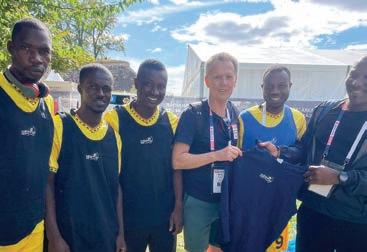
Bill Hunter (middle) presents members of the Ghana team with donated football singlets and shirts.
to change perceptions and attitudes towards people who are experiencing homelessness.”
“It’s a privilege to be a chaplain at the Homeless World Cup. ‘A ball can change the world!’” said Bill.
by Amanda Brummell-Lennestaal

God is real to me – though not always in the way I expect or desire. There are days when God feels intangible, like mist –hovering just out of reach. Other times, God feels utterly unreal, like an old story I’ve forgotten how to believe. Yet, I’ve come to realise that these absences, too, are part of the story.
God becomes most real to me not in certainty, but in encounter – in fragments, in glimpses, in echoes. I’ve seen God in the courage of those who have fought for justice, dignity and peace. I hear God in the stories others share: confessions, memories, aching laughter. These human stories don’t
always name God, but they carry God’s weight.
I perceive God in the lines of sandstone cliffs near my parents’ house –weathered and shaped by time and tide. That quiet endurance feels like a sacred text in its own right.
But most of all, I’ve encountered God in

hospitals, courtrooms and prisons. In my work, I’ve seen the divine flicker in fragile places: a mother holding her breath beside a sick child, a man searching for forgiveness behind locked doors, someone whispering truth in a sterile corridor. There, amidst suffering and honesty, God becomes real.
The common thread is humanity. The image of God is most visible to me in the authentic, the raw, the vulnerable – the sacred ordinary. God is real in the profound and the painful, the quiet and the chaotic.
Even when God feels absent, I perceive I’m still held. Not in constant
clarity, but in the memory of those moments when God felt unmistakably present. Those moments tether me. They remind me that God may not always feel real – but they are.
Amanda BrummellLennestaal is General Manager, Diversity Equity and Inclusion, for The Salvation Army Australia
Stan Grant tells Simon Smart about his withdrawal from the world of media and his return to soil that reminds him of God’s presence
Two years ago, awardwinning Australian journalist and Wiradjuri man Stan Grant walked away from media, following sustained racial attacks. Recently, he caught up with Simon Smart from The Centre for Public Christianity for a chat on the centre’s podcast, Life & Faith. Stan has also recently released Murriyang: Song of Time, a book he describes as a “Wiradjuri Book of Prayer”. We are featuring some of Stan’s words from the podcast to show one man’s quest for love, hope and connection to God and Country.
In the interview, Stan discussed the impact his long-term reporting on wars, disasters, terror attacks and tragedies had on him. He described how everything that went wrong in his life – including something as minor as running out of milk – began to feel like a disaster after years of facing constant devastation. He talked
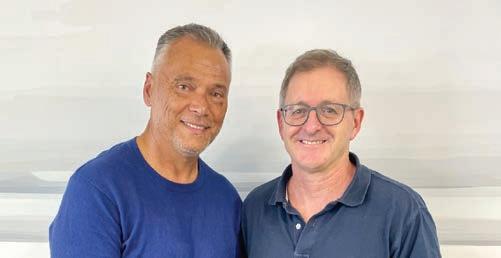
about how a catastrophe becomes normalised for those who are exposed to it on a daily basis, and it also begins to feel like the only aspect of life that still holds meaning.
“The world I was reporting on was not the real world,” Stan said. “The real world is buying milk. The real world is dropping your kids off to school. The real world is watching television with your wife or your husband. The real world is taking your dog for a walk.”
Stan described becoming suicidal as a result of his work and seeking medical
care to “come back” to himself.
“It takes a terrible toll on you,” Stan said. “Two of my closest friends that I worked with are no longer with us. Another one of my friends that I worked with very closely had a similar breakdown and has not really recovered. As for me, I live with it every day. I factor things into my life to take care of myself. I try to avoid the things that are going to trigger those emotions again.
“I’m hypervigilant – I try to bring routine into my sleep and my exercise and all the things I have to do
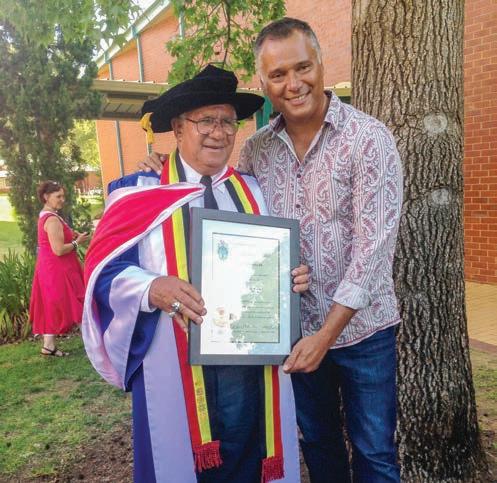
to regulate my moods, to attend to my mental health and to keep those demons at bay, because once you have seen them, you don’t stop seeing them.”
God’s presence
Stan described how, despite his lifelong faith, God felt distant. It was through reconnecting with his Wiradjuri roots, listening to his father’s words, and reflecting on the significance of being on Country as he returned to Wiradjuri land that he began to feel God’s presence again.
“When I sit on Country, it isn’t the rocks and the trees that speak to me,”
Stan told Simon. “It is God in the rocks and the trees. Too many people put a big burden on Country. They want Country to heal them. Country can’t take any more of their pain, but God can take it all. That’s the lesson of [my] dad’s life. We are saved by God in the country that God gave us.”
For Stan, God “re-enchanted” his Wiradjuri soul in communion with others who also follow Jesus. “There is room for us all from our cultural traditions, our backgrounds, but in that body of Christ, we also become one,” Stan said.
“And that is the fulfilment for me of being a First Nations person or Wiradjuri person. It is not that I go to church to be seen as a Wiradjuri person, to be celebrated as a Wiradjuri person, recognised as a Wiradjuri person. I go there to be fulfilled in the presence of others, to bring myself in union with them, to be closer to God. I am fulfilled in that. That’s what enchants my Wiradjuri soul.”
Stan spoke of the fear that exists in Christendom toward Aboriginal cultural ties, and the perception that First Nations people were looking to ’fashion‘ Christianity in the image of their culture.
“God did not arrive on the First Fleet,” Stan says. “Because the people who came here with the Bible in their hand could not see God when God appeared in front of them in us on the land that God had given us … that is their failure, not ours.”
In this podcast, Stan goes on to talk about forgiveness, the diminishing of God in Western culture and the increasing politicisation of faith. Listen at tinyurl. com/5n6krvcm

Ingredients
125g melted butter, 1 cup sugar, 2 tbsp golden syrup, 1 egg, 2 ½ cups self-raising flour, 1 tbsp ground ginger Method
Preheat oven to 180°C.
Combine melted butter, sugar, golden syrup and egg in a bowl.
Add flour and ginger. Stir well.
Roll into small balls and place onto greased baking tray. Flatten with fork or spoon.
Bake for 15 minutes until cooked.
When cooled, they can be stored in an airtight container for one week.
International Day of Peace – 21 September
“Peace is not merely a distant goal that we seek, but a means by which we arrive at that goal.”
– Martin Luther King Jr
Quiz
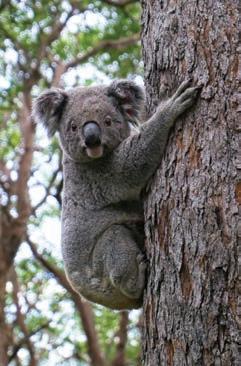
1. What does the word koala translate to?
2. How do koalas get most of their water?
3. What is a baby koala called?
4. How long do koalas spend sleeping?
5. How many babies can a mother koala raise at once?
6. How big is a joey when it is born?
Tum-Tum

On which page of this week’s Salvos Magazine is Tum-Tum hiding?
On this day
21 September, 1937
The Hobbit, by JRR Tolkien, is published. A young adult fantasy novel that follows the adventures of Bilbo Baggins.
23 September, 1909
The novel Phantom of the Opera, by Gaston Leroux, makes its debut as a series in the French newspaper, Le Gaulois. The novel was later adapted as a musical and a film.
23 September, 1889
Nintendo is founded. Originally a card company called Nintendo Koppai, based in Kyoto (Japan), it produced and sold playing cards called Hanafuda.
6. The size of a jellybean. Tum-Tum: is hiding behind the bag on page 7.
4. Up to 20 hours a day. 5. One.
Quiz: 1. No water. 2. By eating eucalyptus leaves. 3. A joey.
Fill in the grid so that every row, every column and every 3x3 box contains the digits 1 to 9.
a laugh
What did the broom say to the vacuum cleaner?
I’m tired of people pushing us around.
I think I want a job cleaning mirrors.
I start my new job as a street cleaner today.
There’s no training, you just pick it up as you go along.
My friend got a PhD in washing machines.
It’s something I could see myself doing. Now they call him the spin doctor.
Bible byte
“I am leaving you with a gift – peace of mind and heart.”
John chapter 14, verse 27 New Living Translation

